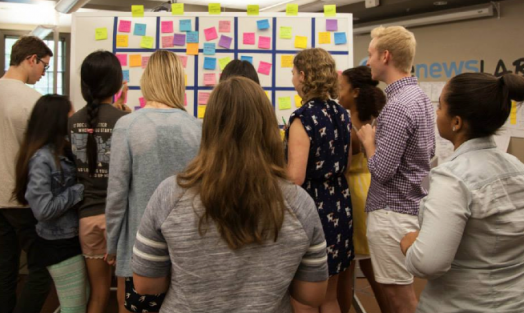Take these three words: journalism, innovation, and education. Add them together. What do you get?
Some people get a challenge. Innovating in journalism education isn’t easy. The media moves quickly. Traditionally, higher education does not.
Some people get a question. There are innovative journalism educators out there. So, how do they do it?
Finally, some people get a mission. These people are the innovators. Despite the challenges the media industry faces right now, they want to push forward and figure out what’s next.
I heard about journalism innovators for the first time in my Media Management & Policy class at UNC during the spring of 2014. Like many other classes I’d taken, the professor told us about the industry’s broken revenue models, declining subscriptions, and other problems that media organizations face. What he said next blew my mind. He explained that, for years, media organizations operated like they knew customers’ needs better than the customers did. The media industry rarely asked what the customers wanted. Now, the customers are in the driver’s seat. Media organizations have to listen to customers in order to survive, like the vast majority of other businesses.
It intrigued me that there are people out there who embrace this reality. These people are the journalism innovators. They combine experimentation and pragmatism to figure out how to keep the media industry alive and healthy.
At this point in my journalism education, I was still getting used to the fact that most of my peers would never be traditional print reporters. But that day in Media Management, it was clear that I had to let go of the past and move forward with speed and energy. I was eager to learn what’s next for the media. I had officially gotten the “innovation bug.”
When I was presented with the opportunity to write an honors thesis in the UNC School of Journalism and Mass Communication (speaking of the future, the school’s new name is the School of Media and Journalism), I jumped at the opportunity to study journalism innovators.
I added one more element to my thesis topic in order to narrow my scope – education. I wanted to combine the “what’s next” of journalism with the “who’s next.” Journalism educators lie at this intersection. Journalism students are the “who’s next,” and their teachers help them answer (and even create) the “what’s next.”

Reese News lab students pitch innovative ideas to their peers during fall orientation. Image from Reese News Lab.
In August 2014, I began my eight-month study on innovations in journalism education. Through interviews with eight educators from schools like University of Florida, City University of New York, University of Nevada, Reno, and University of Navarra, I learned the processes that innovative educators use when innovating (one participant called it “snak[ing] your way to success”). I discovered the approach innovators take to evaluating their work, the words that innovators dislike (“innovation” was one of them), and their best practices in teaching journalism.
Most importantly, I discovered what I hope will be the most impactful conclusions – what journalism schools can do to be more innovative. My desire is that the educators’ stories and insights will move us closer to finding the answer to that wonderful question — what’s next?
Kendra Benner (@KendraBenner) is a media entrepreneurship researcher and innovation nerd. She graduated from UNC-Chapel Hill in May and she’s interning at Reese News Lab this summer. Her dream job is to travel around the world and help journalism schools become more innovative. (If you’re interested, let her know!) She loves elephants, coffee shops, and adventure. Connect with her at [email protected].
This story originally appeared on Reese News Lab.
![]() Reese News Lab is an experimental news and research project based at the School of Journalism and Mass Communication at the University of North Carolina at Chapel Hill. The lab was established in 2010 with a gift from the estate of journalism school alum Reese Felts. The Lab develops and tests new ideas for the media industry in the form of a “pre-startup.” Teams of students research ideas for media products by answering three questions: Can it be done? Does anyone actually need this? Could it sustain itself financially? To answer these questions, students create prototypes, interview and survey potential customers, and develop business strategies for their products. Students document their recommendations on whether they believe a product will work and then present their ideas to the public.
Reese News Lab is an experimental news and research project based at the School of Journalism and Mass Communication at the University of North Carolina at Chapel Hill. The lab was established in 2010 with a gift from the estate of journalism school alum Reese Felts. The Lab develops and tests new ideas for the media industry in the form of a “pre-startup.” Teams of students research ideas for media products by answering three questions: Can it be done? Does anyone actually need this? Could it sustain itself financially? To answer these questions, students create prototypes, interview and survey potential customers, and develop business strategies for their products. Students document their recommendations on whether they believe a product will work and then present their ideas to the public.


